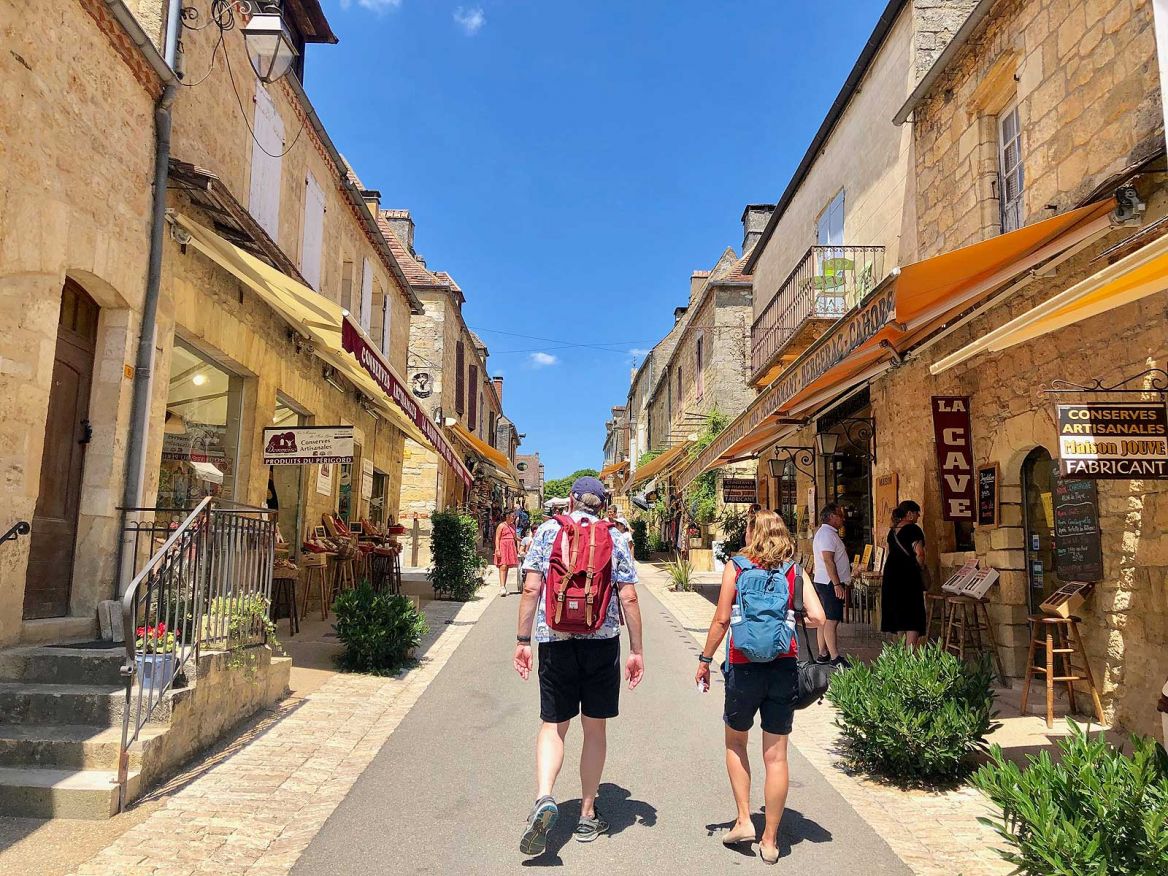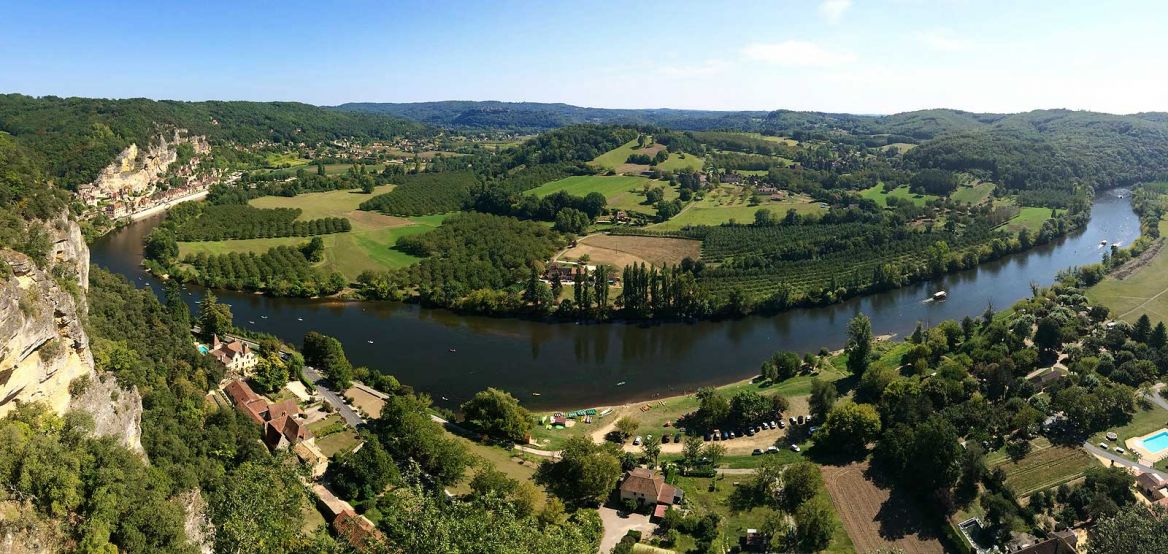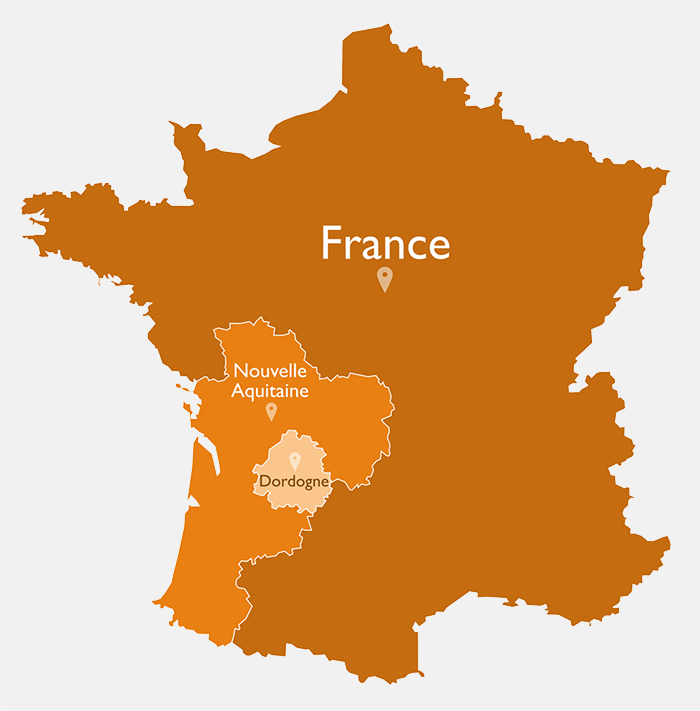- Home page
- Tourism
- Discover
- The Périgord, The Dordogne
- Discover
- Tourism
The Périgord, The Dordogne
Automatic translation
geography
Located in the southwest of France, the Dordogne is mostly part of the Aquitaine Basin and its northeastern fringe is part of the Massif Central. With an area of 9,060 km2, the Dordogne is the third largest French department. Its population is estimated at 41,500 inhabitants in 2010. Its main cities are: Périgueux (capital of the department), Bergerac, Sarlat, Nontron, Terrasson and Ribérac.
climate
The Dordogne benefits from a very temperate climate which will make your stays pleasant in all seasons.
Summer is of course the perfect season to enjoy all the assets of the Périgord. Temperatures vary between 25° and 35°. The sun is generally omnipresent, even if storms often come to disrupt the atmosphere and bring a little much-appreciated freshness. The temperature records in summer date back, as everywhere in France, to the summer of 2003, with +42° in certain places in the Périgord!
Autumn and winter, under the influence of the ocean, are generally mild and humid, punctuated by episodes of cold that are rarely intense, with some exceptions. For example, records of -20/-25° can be noted during the last freezing winter in the region in 1985/86. The influence of the nearby ocean, winter is also marked by fairly frequent gales. The most infamous was in 1999 with the storm that swept through the region and devastated the forests with winds of over 170 km/h.
history
Different periods characterize the history of Périgord.
Prehistory
- The Paleolithic : ice age characterized by the presence in Périgord of reindeer and mammoths, traces of which can be found in the paintings and engravings of certain famous caves in the department ( Rouffignac, Lascaux, etc.).
At this time, prehistoric men (whose traces date back 400,000 years) lived at the foot of the limestone cliffs. This is why the main prehistoric sites of the Paleolithic are distributed in the valleys of the Vézère and the Dordogne.
- The Neolithic period (3,000 years BC): this corresponds to the sedentarization of man and the development of agriculture with the appearance of metalworking (copper, bronze, iron).
Antiquity
It is characterized by the birth of the territory of the petrocores (Gallic community dating back to 400 BC) which, after the Gallic War, became one of the cities of the Roman province of Aquitaine whose capital is Vesunna.
During this period, Vesunna acquired significant urban facilities (aqueducts, amphitheaters, etc.), some of the remains of which can be found within the current walls of the city of Périgueux.
The Vesunna Museum is open all year round. It is the ideal place for a cultural afternoon for all ages.
Discover the magnificent contemporary and bright building, designed by the architect Jean Nouvel to enhance these remains, in the very heart of the city of Périgueux.
Watch our video report and read our article.
The Middle Ages
There are more than 1000 castles, manors and manor houses in the Dordogne, which are mostly spread along the valleys of the Dordogne, the Vézère, the Isle and the Dordogne.
The construction of these castles extended from the 11th century to the Revolution, which is why the castles as we can visit them today are characterized by the juxtaposition of various architectural trends.
The Château de Bourdeilles in Périgord Vert is a site where two eras coexist. There is the keep and the 12th century castle as well as another castle dating from the Renaissance, with a magnificent garden. On site, two visits as well as workshops to understand the interweaving of these two eras. Click to see our video report on the Château de Bourdeilles 20 minutes from Périgueux.
As for the bastides created in the 13th and 14th centuries, and located in the southwest of the department (Pays du Dropt), they bear witness to the confrontation between the King of England and the Count of Toulouse (whose bastides were built in Agenais). The major characteristic of a bastide is its geometric plan articulated around the Market Square (Monpazier).
discover the Périgord
The 4 Colors of Périgord
We propose to present them to you in our chapter "Visit of Périgord", go and take a quick look. You will discover an overview of the historical, architectural and natural riches of each Périgord.
- The White Périgord : around Périgueux and the Isle valley...
- The Périgord Noir : Sarlat, the main concentration of sites and castles, the forests, the Vézère and Dordogne valleys.
- The Green Périgord : the green Périgord from Nontron to Excideuil, the Périgord regional natural park, Limousin, Brantôme, the Dronne valley...
- The Purple Périgord : Bergerac and its vineyards, the South Dordogne and its "Bastide Country"...

Walk in Domme
Tourist Sites
Périgord is without a doubt one of the French departments with the greatest number of riches : castles, abbeys, country houses, priories, deposits and troglodyte sites, caves and chasms, gardens, museums and theme parks... A multitude of reasons to stay in the region to be discovered in detail in the chapter "Tourist Sites".
From the richness of local products...
Some of the products from Périgord are world-famous. Here is a little overview:
- The wines of Bergerac, the famous Monbazillac, and the renowned Pécharmant;
- Liqueurs and spirits from the old distilleries of Périgord;
- Walnut, strawberry, chestnut, tobacco...;
- Foie gras, truffles, porcini mushrooms from Périgord...;
- Confit, duck breasts, grattons, pâtés, tourins, Sarladaise potatoes and Périgueux sauces...
Visit our Périgord Gastronomy chapter!
Bergerac Duras wines come from a modern vineyard, with winegrowers who are passionate about their work and keen to offer quality taste and a gastronomic experience of choice to everyone. The specialties of Périgord pair perfectly with these wines.
Go for a country picnic with products from Périgord.
To the richness of the Périgourdine table and cuisine
Gastronomy is one of the pillars of Périgord life. Each village or bastide in Périgord has its markets for foie gras, truffles or porcini mushrooms (in season) without forgetting the Festival du livre gourmand which takes place in Périgueux! There are plenty of good restaurants in Périgord, don't hesitate to stop there to taste the local cuisine, its tourin, its foie gras, its confits, its cheeses (cabécou), its desserts.
your accommodation
In our "Accommodation" chapter you will find all the possibilities available to you, from the best campsites to gîtes and furnished accommodation, holiday villages, guest houses in the Dordogne to classified hotels, the Périgord contains a multitude of possibilities from the greatest luxury to the most typical accommodation, your desires will be satisfied!
Grand Etang campsite
Grand Etang campsite
CAMPING DE SAINT ESTèPHE: Nature and relaxation await you! The Saint-Estèphe campsite, located in the heart of the ...
Saint Estèphe
Rouffiac campsite
Rouffiac campsite
CAMPING DE ROUFFIAC: Experience a nature holiday in the heart of the Dordogne! Want to disconnect in the heart of ...
Angoisse
Château de Lasfonds
Château de Lasfonds
CHÂTEAU DE LASFONDS: THE BEST LUXURY CASTLE FOR WEEKLY RENTALS IN THE PERIGORD VERT A Historic Estate Surrounded by ...
Rochebeaucourt et Argentine
sports and leisure
A multitude of activities will be offered to you to discover the riches of our beautiful Périgord: rides in a little train or in a horse-drawn carriage, descent of the Dordogne, the Dronne or the Vézère by canoe or gabare, rides in a helicopter, in a hot-air balloon, by plane, in the air, on the water, underground or by walking the trails! In short, a multitude of possibilities to discover in our "Sports and Leisure" chapter, whether indoors, outdoors, on the water or in the air.
The Dordogne is a paradise for canoe and kayak enthusiasts. Follow us for a sporty getaway between La Roque-Gageac and the beautiful hilltop village of Beynac. On the river route of the castles, we take in the sights, we enjoy the gentle way of life in Périgord... We tested for you: Canoe Kayak on the Dordogne: between sport and leisure.
Vignoble des Verdots
Vignoble des Verdots
Explore the natural beauty of the Verdots Vineyard and its surroundings through our hiking trails. Immerse yourself ...
Conne de Labarde
Château Lestevenie
Château Lestevenie
At Château Lestevenie we create an experience of good wine, the beauty of nature and the French countryside to ...
Gageac et Rouillac
Combas Village de Gîtes
Combas Village de Gîtes
Combas Village de Gîtes, a 100% nature destination for groups in Périgord Noir Drop off your bags and enjoy an ...
Saint Crépin et Carlucet
events in Périgord
Périgord is the privileged location for a multitude of festivals, celebrations, cultural and culinary events throughout the year, details of which you will find in our "Agenda", including:
- Truffle festival and foie gras and truffle culinary academy in Sarlat in January (over a weekend);
- Walnut festival in Sarlat in February ;
- Sarlat Fest'Oie at the beginning of March (over a weekend);
- Saint George's Day Festival , early May in Périgueux, the largest funfair in the Dordogne department for over 100 years;
- Local Food Days in Sarlat on Thursday and Friday of Ascension Day;
- Félibrée in July (1st Sunday). This is an Occitan folk festival that takes place in a different town each year;
- “Culture aux Coeurs” Festival in Montignac-Lascaux in July ;
- “Fest’in Riberac” in Ribérac in July ;
- The Périgueux Summer Truffle Markets in July and August in Périgueux;
- Arts & Gestes Mimos Festival in Périgueux in August ;
- Sarlat “Theater Games” Festival in July and August ;
- Festival of the Pays d’Ans in Périgord Vert in July and August in Tourtoirac, Badefols and Hautefort;
- “Les Estivales” in Bergerac in July and August ;
- Knife festival on the first weekend of August in Nontron;
- Black Perigord Music Festival in August in Saint-Léon-sur-Vézère;
- “Sinfonia en Périgord ” Festival at the end of August/beginning of September in Périgueux and surrounding areas;
- Gastronomy Days, end of September (over a weekend);
- Gourmet Book Festival in November in Périgueux;
- International Film Festival in Sarlat in November.
Do you know the Mimos Festival ? It is the festival dedicated to the Arts of Mime and Gesture . It is organized every year during the summer in Périgueux and it is a celebration not to be missed. In the city and in beautiful venues, free shows and others are offered by great artists who will make you vibrate...
We tested the Mimos Festival in Périgueux for you!
Périgord in books and cinema
Périgord is of course the subject of a large number of historical and practical publications, among which we will note:
Tourism, Culture, History and Gastronomy
- "Le Périgord" from Editions "Ouest France";
- “The colors of the Dordogne” from “The creations of the Pelican”;
- "The Castles of Périgord" from "Ouest France" Editions;
- “Prehistoric sites in Périgord” from “Ouest France” Editions;
- "The bastides of Périgord" from "Editions Ouest France";
- "The Périgord of Jacquou le Croquant" by G. Fayolle at "Hachette Littératures";
- “Tales of the Dordogne” by M. Cosem, published by Editions Fanlac;
- “Traditional recipes from Périgord” by J.Leymarie at “Ouest France”.
Literature
- “Jacquou le Croquant” by Eugène Le Roy at “Pocket”;
- "From Thrushes to Wolves" by Claude Michelet, "Pocket" Editions;
- “Malevil” by Robert Merle Editions “Gallimard”;
- “The River of Hope” by Christian Signol at “Pocket”;
- "The Merchant of Bergerac" by Guillemette de la Borie, "Presses de la cité" editions.
- "The Périgord Quercy Green Guide" from "Editions de Voyages - Michelin";
- "Le Petit Futé Dordogne" in the "New University Editions";
- "The Backpacker's Guide";
- The Annual Review of the CDT Dordogne presenting all the tourist sites and walks in Dordogne Périgord, published before the summer;
- The various publications and documentations of the Dordogne Departmental Tourism Committee.
Recommended practical works
Movie theater
Périgord is a very popular filming location , more than a hundred films have been shot there, including:
- "Le Capitan" in 1960 by André Hunebelle with Jean Marais and Bourvil in Biron, Hautefort and Monpazier;
- "The Tattooed One" in 1968 by Denys de la Patelière with Jean Gabin and Louis de Funés in Domme;
- "The Three Musketeers" by Claude Barma in 1968 in Sarlat, Castelnaud and Fénelon;
- "The Butcher" in 1970 by Claude Chabrol with Jean Yanne and Stéphane Audran in Trémolat;
- "Molière" by Ariane Mnouchkine in 1978 in Hautefort;
- "Les Misérables" in 1982 by Robert Hossein, with Lino Ventura in Monpazier and Sarlat;
- “Périgord Noir” in 1989 by Nicolas Ribowski with Roland Giraud and Jean Carmet in Sarlat;
- "Les Bois Noirs" in 1989 by Jacques Deray with Béatrice Dalle in Clermont de Beauregard;
- “La Soule” by Michel Sibra in 1989 in Beaumont and Issigeac with Richard Borhinger;
- "La Fille de d'Artagnan" in 1994 by Bertrand Tavernier with Sophie Marceau and Philippe Noiret at the Château de Beynac and in Sarlat;
- "La Rivière Espérance" in 1994 by Josée Dayan, with the Dordogne River as the main setting;
- The True Story of Cinderella in 1998 by Andy Tennant in Hautefort with Drew Barrymore and Anjelica Huston;
- “The Visitors II” by Jean Marie Poiré in 1998 in Beynac;
- "Joan of Arc" in 2000 by Luc Besson with Milla Jovovich, Dustin Hoffman and John Malkovich at the Château de Beynac;
- “Le Pacte des Loups” in 2001 by Christophe Gans with Sameul le Bihan, Vincent Cassel, and Monica Belluci in Jumilhac le Grand and at the Château de Puyguilhem;
- “Fanfan la Tulipe” in 2002 by Gérard Krawczyk in Monpazier;
- "Jacquou le Croquant" in 2007 by Laurent Boutonnat, all over Périgord...

Dordogne Valley on the heights of Marqueyssac





















